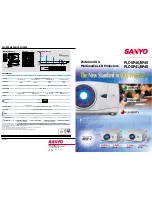
65
3D FUNCTION
•
Elderly viewers may have a reduced depth perception than younger
viewers. Avoid watching video nearer than the recommended distance.
•
Watch 3D images within the optimum viewing angle and distance.
•
If you are outside the viewing angle or distance, you may not be able to
see 3D images. You cannot view 3D images when you are lying down.
•
You may see left and right images overlapped during projector
initialization after it is powered on. It may take some time for
optimization.
•
It may take some time for the 3D image to look normal after you turn
your eyes away from the screen and look back at the 3D image.
•
It may flicker slightly while watching 3D images under a 3 wavelength
lamp fluorescent light (50 Hz to 60 Hz) or near windows. If so, it is
recommended to block the sun light with a curtain and to dim the lights.
•
The 3D glasses must be DLP-LINK (DLP Ready) type.
•
You may not be able to watch 3D properly if there is an obstacle
between the projector and 3D glasses.
•
Install the 3D projector as far as possible from other devices.
•
If a future 3D broadcasting format that is not supported by this projector
becomes the standard, an additional device such as a set-top box may
be required.
Please check the following when using 3D glasses.
•
Do not use 3D glasses as ordinary glasses, sunglasses, or protective
goggles.
-
If you do so, this may cause injury.
•
Do not store 3D glasses in very hot or very cold conditions. If you do,
this may cause them to become distorted. Do not use distorted glasses.
•
Do not drop 3D glasses or allow them to come into contact with other
objects.
-
This may cause product malfunction.
•
The lenses of 3D glasses are easily scratched. Use a soft clean cloth
when cleaning them.
•
Foreign particles on the cloth may cause scratches.
•
Do not scratch the surface of the 3D glasses' lenses with sharp objects
or wipe them with chemicals. If the lenses get scratched, images may
not look normal when viewing 3D.
















































